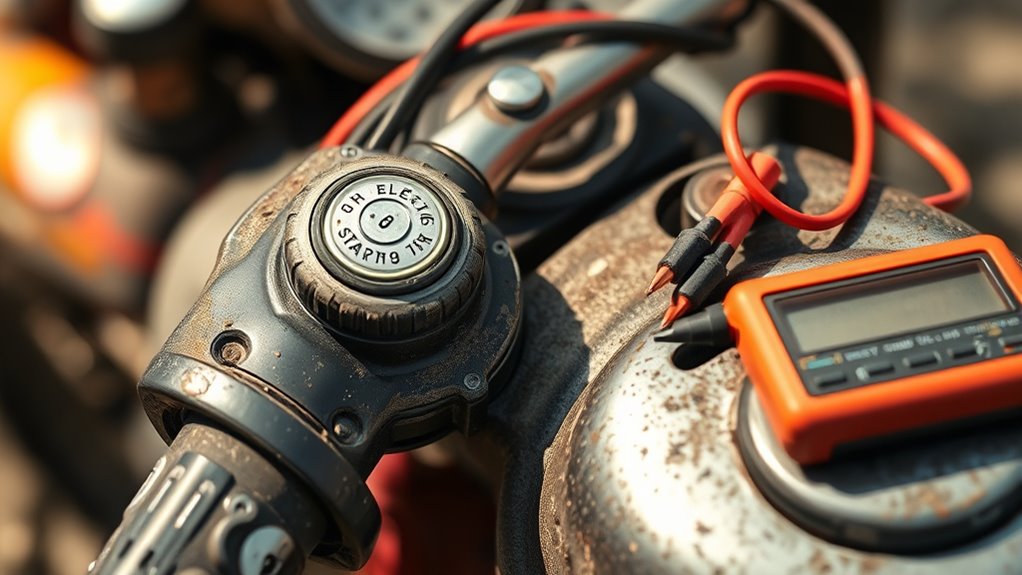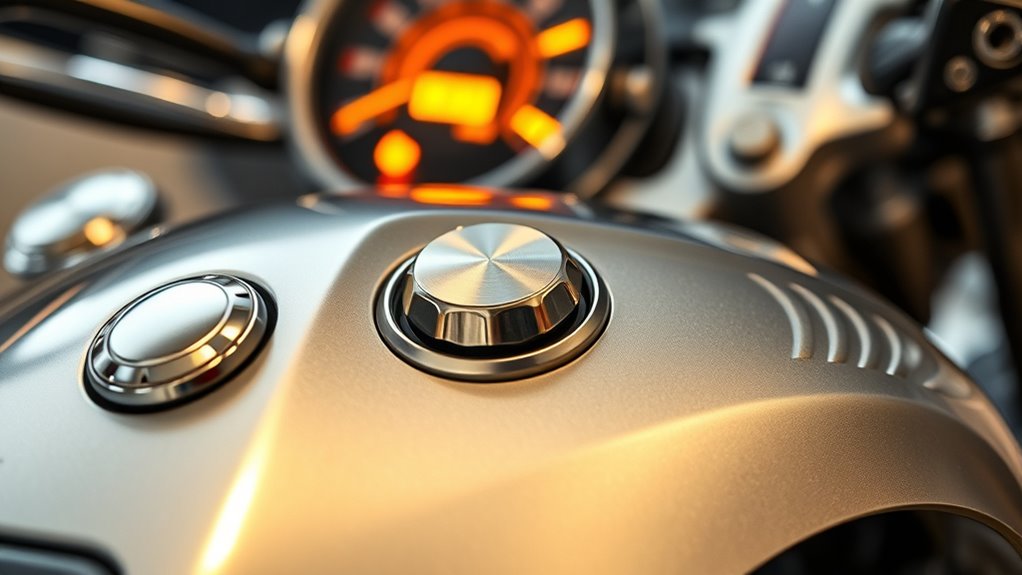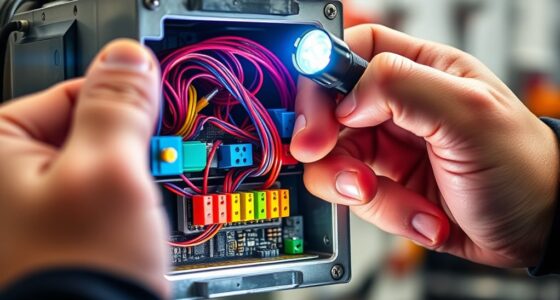If your electric start won’t crank, start by checking the battery voltage with a multimeter—ideally around 12.6V—and clean or tighten corroded terminals. Listen for clicking sounds to identify a faulty solenoid, and test by bypassing it if needed. Inspect fuses and wiring for damage or loose connections, and verify your ignition switch functions properly. Following these steps can quickly diagnose the problem; if issues persist, you’ll discover more ways to troubleshoot further.
Key Takeaways
- Verify the battery voltage and ensure terminals are clean and tightly connected.
- Test the solenoid for proper operation; replace if it fails to engage the starter.
- Inspect fuses and wiring for damage, corrosion, or loose connections, and replace or repair as needed.
- Check the ignition switch for proper function and replace if it does not send power when starting.
- Bypass the solenoid or ignition switch temporarily to identify if these components are causing the issue.

If your electric start won’t crank, it can be frustrating, but the issue is often something you can troubleshoot yourself. One of the most common causes is battery issues. If the battery is dead or weak, it won’t supply enough power to turn the starter motor. Start by checking the battery’s voltage with a multimeter—ideally, it should read around 12.6 volts when fully charged. If it’s considerably lower, the battery might need charging or replacement. Sometimes, corrosion on the battery terminals can prevent proper electrical contact. Inspect the terminals for any buildup of white or greenish residue, and clean them with a wire brush or a mixture of baking soda and water. Tighten the connections afterward to guarantee a solid contact point. If your battery is old or failing to hold a charge, replacing it often resolves the problem quickly.
Another frequent culprit is solenoid failure. The solenoid acts as a switch that engages the starter motor when you turn the key. If it’s faulty, you’ll hear a clicking sound but the engine won’t turn over. To diagnose this, listen for the click when attempting to start the engine. If you hear the click but the engine doesn’t crank, the solenoid may be bad. You can test this by bypassing the solenoid with a screwdriver or a jumper wire—carefully bridging the terminals to see if the starter motor engages. If it does, you’ll need to replace the solenoid to restore proper starting function. Sometimes, dirt or moisture can cause the solenoid to stick or fail prematurely, so keep it clean and dry.
Beyond battery and solenoid issues, other electrical components can cause starting problems. Check the fuse box for blown fuses, as a blown fuse can interrupt power to the starter circuit. Also, examine the wiring for any signs of damage, corrosion, or loose connections. Sometimes, a simple reset of the circuit breaker or replacing a blown fuse can fix the issue. If all these components seem fine, you might want to test the ignition switch itself, as a faulty switch can prevent power from reaching the starter.
Frequently Asked Questions
Can a Dead Battery Cause the Electric Start to Fail?
Yes, a dead battery can cause the electric start to fail. Battery issues are a common culprit behind starting problems, as a weak or dead battery can’t supply enough power to the starter motor. Electrical problems often stem from faulty batteries, corroded terminals, or poor connections. To fix this, check your battery’s charge, clean the terminals, and guarantee connections are tight. If problems persist, replacing the battery might be necessary.
Is It Necessary to Replace the Ignition Switch?
You don’t always need to replace the ignition switch if your electric start isn’t working. Sometimes, a faulty switch is the culprit, but it could also be wiring issues or a dead battery. If replacement is necessary, expect the ignition switch cost to be around $50 to $150, depending on your vehicle or equipment. Consider having a professional diagnose the problem first to avoid unnecessary replacements and save on costs.
How Do I Test the Starter Relay?
Testing your starter relay is like detective work—careful and precise. First, locate the relay and inspect the circuit for any visible damage or corrosion. Then, perform relay testing by swapping it with a similar one or using a multimeter to check for continuity. If the relay doesn’t click or show continuity, it’s faulty. Conducting thorough circuit inspection helps identify underlying issues that could be preventing your engine from cranking.
Could a Faulty Spark Plug Affect Starting?
A faulty spark plug can definitely affect starting your engine. You should inspect the spark plug for signs of wear, damage, or carbon buildup, and verify it’s firing correctly. Poor ignition timing can also cause starting issues, so double-check that your timing is properly set. If the spark plug isn’t functioning well or the ignition timing is off, your engine may struggle to start or not start at all.
What Safety Precautions Should I Take Before Troubleshooting?
Before troubleshooting, you should wear safety gear like gloves and safety glasses to protect yourself. Always disconnect the power by turning off the switch or unplugging the device to prevent accidental start-up. Make sure the area is dry and free of debris. Double-check that the power disconnect is secure, and never work on electrical components while the device is plugged in. Taking these precautions keeps you safe during troubleshooting.
Conclusion
If your electric start won’t crank, don’t get discouraged. Check the basics first—battery, connections, and safety switches—before calling for help. Sometimes, a simple fix is all it takes to get your engine running again. Remember, a problem shared is a problem halved, so don’t hesitate to troubleshoot thoroughly. Staying patient and methodical can save you time and money, proving that an ounce of prevention is worth a pound of cure.








